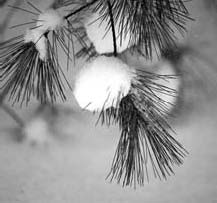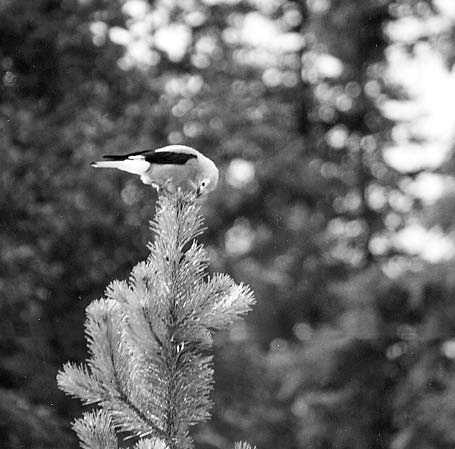 Taiga, or Boreal Forest
Taiga, or Boreal Forest
 Taiga, or Boreal Forest
Taiga, or Boreal ForestThis sheet is designed as an introduction to what has been called the boreal, northern, taiga, or "spruce-moose" forest biome.
The northern forest extends in a huge, circumpolar tract from Alaska and Canada to Siberia and across Scandinavia. If there were as much land in the Southern parts of the Earth, there would be an equivalent forest there, too. In many boreal forest areas, stretches of forest alternate with bogs filled with peat and shrubs with thick waxy leaves. Traveling across the Canadian Shield takes one into deep forest, then across a bog, then into forest, and back to a bog for days of travel. One sees fewer species of either plants or animals this far north, especially in winter.
 Adaptations: The Tough Pine Needle
Adaptations: The Tough Pine Needle The pine needle is adapted to withstand severe cold and long droughts. (Even though ice is all about them, that water is unavailable to plants.) The needles are shaped to allow snow to slip off, are dark in color so they can absorb maximum amounts of heat from the sunshine, and are coated w with resin to help hold with moisture. Resinous antifreeze in the outside cells keeps the needles from freezing. Their breathing pores, or stomata, are strategically placed in pits placed along the bottom of a groove running the length of the needle. The stomata create a protective layer of still air over the needle, helping them avoid moisture loss through water vapor.
Conifers get help in absorbing nutrients from hundreds of species of fungi living in their roots. Because pine needles are so tough, they decompose very slowly. Since the rate of decomposition increases as temperature increases (because bacterial decomposition is temperature-induced) and the northern lands are cold, a spongy mat of undecomposed organic material remains on the surface of the ground. Nutrients do not get into the ground easily and the soil is therefore acidic and poor.
 Cones protect seeds through cold winters and other natural challenges. One tree, the Jack Pine (growing in the poorer soils of the boreal areas), releases its seeds only after a fire, or at a temperature of 46.7 deg.C (116 deg.F). Animals have developed ways of dealing with cones, taking them apart and storing them. Birds, for example, have developed powerful bills to pry them open.
Cones protect seeds through cold winters and other natural challenges. One tree, the Jack Pine (growing in the poorer soils of the boreal areas), releases its seeds only after a fire, or at a temperature of 46.7 deg.C (116 deg.F). Animals have developed ways of dealing with cones, taking them apart and storing them. Birds, for example, have developed powerful bills to pry them open.
In general, there aren't too many species in the northern forests and the different species resemble each other all around the world. Moose and elk, caribou and reindeer, for example, look substantially the same no matter which forest they inhabit. In general, animals living above the snow line are large and carry fat in storage.
The boreal forests are being over logged. Clear cutting disrupts the natural process of soil replenishment. Average Americans use far more paper (272 kg per person every year) than their counterparts around the world, for example in Europe - 60 kg per year - and Asia - 10 kg per year. Can you think why?
The boreal forests are also vulnerable to acid rain and ozone. A detailed analysis of pine needles can disclose the type and extent of injury.
References include:
Andrews, William A. and Donna K. Moore, Investigating Terrestrial Ecosystems
(Scarborough, Ontario: Prentice-Hall Canada, Inc., 1987).